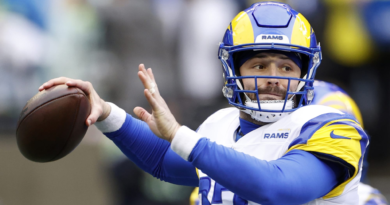Why the Patriots should really consider drafting WR Marvin Harrison Jr. at third overall
FOXBOROUGH, Mass. — Quick-hit thoughts and notes around the New England Patriots and NFL:
1. Harrison at No. 3: By the time director of scouting Eliot Wolf and the Patriots’ personnel and coaching staffs complete their evaluation process in late April, the best-case scenario for them would be if they are convinced by the three top quarterbacks — USC’s Caleb Williams, LSU’s Jayden Daniels and North Carolina’s Drake Maye.
Picking one of them at No. 3 — likely Daniels or Maye — would mean they decisively believe they’ve identified their quarterback of the future. Few would argue it’s the most important position.
But what if that conviction ultimately isn’t there?
This is where Ohio State wide receiver Marvin Harrison Jr., barring a tantalizing offer to trade back, likely enters the chat. Wolf said at the NFL scouting combine that one of his goals is to “weaponize” the offense, which head coach Jerod Mayo described as identifying players “the defense has to prepare for — whether that’s double-teaming or anything like that.”
How often did Harrison, whom Wolf said fits any offensive system, see double teams at Ohio State?
“Every game,” Buckeyes offensive coordinator/receivers coach Brian Hartline told ESPN, before sharing what traits stand out most to him.
“Once you get to a certain level, ‘eliteness’ is found from the neck up. I think that kind of embodies Marv. He has a high ceiling that God blessed him with, that his parents have brought along in him. But his ability, individually, to maximize what he is capable of, is really the [secret] sauce to reaching the top.
“Yeah, he reached the highest of highs as a college receiver. But that’s the shortest thing on his goal list when it comes to his career. It’s not how he talks. It’s not what he wishes happens. It’s his daily routine. It’s his lifestyle. It’s a whole different ballpark than most people will probably understand.”
Harrison, who measured 6-foot-3 and 209 pounds at the combine, totaled 155 receptions for 2,613 yards and 31 touchdowns over his three collegiate seasons.
Hartline played receiver in the NFL from 2009 to 2015 with the Dolphins and Browns, and what he sees in Harrison’s physical skill set is rare.
“He is an interesting build, if you will. He’s 6-3, but I always felt his lower body was like a 6-footer,” he said. “He actually has a really long torso. He has long arms [31.8 inches]. But his lower half has the transition of a 6-footer, so he’s able to quick-twitch. His acceleration is excellent because of that. He’s low to the ground, so his center of mass is not high-waisted. I think he’s built in a way you’d want to be — tall enough, with a shorter person’s lower half, and then with the ability to run; incredible speed. He’s kind of built like his dad.”
Longtime Patriots fans, of course, need no introduction to Marvin Harrison Sr., who played a central role in the Patriots-Colts rivalry as Peyton Manning’s top target when Tom Brady and Manning engaged in classic duels through the 2000s. Harrison Sr. was inducted into the Pro Football Hall of Fame in 2016 and Hartline shared his belief that Harrison Jr. has an All-American/Hall of Fame makeup as well.
For a Patriots team badly in need of an infusion of offensive talent, but also with players whom Wolf said will fit the culture of doing more than the norm, Harrison might be the safest choice.
“There’s a lot of variables with offenses and quarterback play, and longevity and health and all that, but when it comes from a lifestyle and living the game standpoint, he has all of that,” Hartline said. “He’s an amazing young man. His character, how he operates, how he does what he says, is at an all-time high.”
2. NFLPA survey: One of the goals of the NFL Players Association players report card survey, which was released last week, is to identify areas that teams can improve working conditions for players. Without it, who would have known the Patriots are one of just seven teams that don’t provide daycare support for players’ children on game day?
One obvious theme, as reflected by the Jaguars jumping from 28th last year to fifth this year, is how much a new facility will help a team’s rating. The Patriots’ facility, sparkling when it opened in 2002, was viewed as outdated by players and contributed to the franchise’s unflattering No. 29 ranking.
With everything housed inside Gillette Stadium, the Patriots are unlike most other teams that have standalone facilities. Former assistant Steve Belichick recently noted that there is one window in the team facility.
I’m told team officials previously had extensive discussions and a vision/plan for major changes, which could include everything from stand-alone new offices including an indoor facility on site, among other things. It seems likely that will come to fruition in time.
3. Analytics change: Patriots president Jonathan Kraft was part of the “Future of Football: Innovation on the Gridiron” panel at the 18th annual MIT Sloan Sports Analytics Conference on Friday. Of the many notable topics discussed was how the team will be evolving analytics-wise in the transition from Bill Belichick to Mayo.
“We were so lucky to have Bill the last quarter century because Bill has as good of a set of algorithms as a human being can have in their head, and we benefited from that. Bill was so good, and so much better than his competition at those things, that we didn’t evolve it on the technical side,” Kraft said on the panel hosted by ESPN’s Michele Steele.
“Jerod worked at Optum, which is the division of United Healthcare that was bringing technology to traditional health care to try to evolve that business. I think you’ll see us with Jerod, and Eliot Wolf and Matt Groh — who are running our football operations — start to bring more traditional analytic tools. We have them on our business side. We’ll start to bring them to the football side now.”
4. Kraft on Mayo: On the succession plan of Mayo taking over for Belichick, Kraft said at the conference: “For us, the football side of the building has always been about Bill. We’ve been blessed to be in that situation. When you transition from something like that, in any business, you have to go in a very different direction because nobody can be Bill Belichick.”
Among the things Kraft noted about Mayo was his standing as a former NFL player, and how his post-playing experience in business at Optum has him “well positioned for today’s NFL” to help create a new culture in New England.
5. Onwenu dynamic: As of late last week, pending Patriots free agent offensive lineman Mike Onwenu had not officially hired a new agent, meaning he was technically representing himself in any talks with the team leading up to Tuesday’s deadline for clubs to use the franchise tag. It remains to be seen if that is his plan moving forward.
Director of scouting Eliot Wolf on pending free agent Mike Onwenu moving on from his agent (question via @cpriceglobe): “It doesn’t impact us. Mike is a core player for us. It’s no secret we want to try to keep Mike, and it will just be a little bit of a wrinkle dealing with him….
— Mike Reiss (@MikeReiss) February 27, 2024
6. Maye’s message: When Maye arrived for his meeting with the Patriots at the combine, he told reporters one of the first things he did was congratulate Mayo on being named head coach. Maye said he did the same thing with head coach Antonio Pierce and the Raiders, and Raheem Morris and the Falcons.
In his interview with reporters, Maye also rattled off names of assistant coaches when meeting with other teams, such as Broncos quarterbacks coach Davis Webb, Falcons quarterbacks coach T.J. Yates, Commanders offensive coordinator Kliff Kingsbury and quarterbacks coach Tavita Pritchard, as well as Commanders head coach Dan Quinn, Giants coach Brian Daboll and general manager Joe Schoen.
In doing so, Maye showed he was dialed in and had done his homework.
7. Miller time: The Patriots have about $101 million in salary cap space, according to ESPN’s Roster Management System, an eye-opening total that highlights Richard Miller’s critical role.
Miller enters his 29th season with the franchise and is responsible for managing the cap, player costs, contract research and statistical trends, financial and strategic planning and assisting the personnel department with draft, free agency and game advance analytics. Wolf specifically referenced Miller last week, saying he has helped “make the Patriots go behind-the-scenes over the years.”
8. Tag thoughts: The abundance of cap space makes it more tenable for the Patriots to use the franchise tag on safety Kyle Dugger ($17.1 million) or Onwenu ($20.9 million) by Tuesday’s deadline, although Mayo made it clear that wasn’t the preference.
“You want those guys to be happy and be here for the long term, so that’s the plan,” he said.
9. They said it: “I don’t want to call it a slow burn, because we will be competitive, we will put a good team out there. Will we win a championship? I don’t know, and I don’t want to make those promises. But at the same time, I feel confident about our plan to really turn this ship around.” — Mayo, on if he views the Patriots’ rebuild as one that will take time
10. Did you know: The Patriots have drafted only eight players from Ohio State in their history, but three of those were in the first round — defensive back Tim Fox (1976), receiver Terry Glenn (1996) and linebacker Andy Katzenmoyer (1999). The others were defensive tackle Pete Cusick (third round, 1975), special teamer Nate Ebner (sixth round, 2012) and offensive linemen Mike Ingram (1962), Bob Vogel (1963) and Rod Foster (1963).




